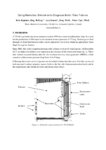TO
Filters: Collection: "ir_eua"
| Title | Date | Subject | Description | ||
|---|---|---|---|---|---|
| 26 |
 |
A comprehensive parametric investigation of efficient soot modeling using high fidelity method of moments | PSD; PAH; nucleation; Soot; Radiation; Method of moment | Soot is one of the most regulated pollutants in all the combustion applications like automotive engines, aviation engines, and industrial furnaces. Modeling soot formation is quite challenging due to the complex processes involved in the formation of the soot particulates. Empirical formulation base... | |
| 27 |
 |
Design Considerations for Carbon-Free Combustion | Decarbonization; Hydrogen Combustion; Carbon Dioxide; Carbon-Free Combustion; CO2 Emissions; Greenhouse Gas Emissions | Combustion of a hydrocarbon produces water and carbon dioxide. As consensus continues to build around the contributions of carbon in global client change, jurisdictions, both internationally as well as domestically, are working towards limiting formation of carbon dioxide. One way to work toward eff... | |
| 28 |
 |
3D CFD model development and validation for once-through steam generator (OTSG): coupling combustion, heat transfer | The current research studies the coupled combustion inside the furnace and the steam generation inside the radiant and convection tubes through a typical Once-Through Steam Generator (OTSG). A 3D CFD model coupling combustion and two-phase flow was developed to model the entire system of OTSG. Once ... | ||
| 29 |
 |
ClearSign eye™: pilot sensor | Clearsign Technologies Corp. has developed and tested a novel, capacitive based flame sensor for use on existing burners in a variety of industrial combustion applications including process burners, boiler burners and flares. ClearSign has developed two probe designs. The first probe design is compa... | ||
| 30 |
 |
Model-based design and full-scale demonstration of an oxy-coal firing system with undiluted oxygen and minimal flue gas recycle | The future use of coal as a fuel for industrial applications depends on economical technologies being made available to capture and store the CO2 emitted as a product of the combustion process. One such technology is oxy-combustion, which involves burning of the fuel using pure oxygen as the oxidant... | ||
| 31 |
 |
Combustion emissions and thermal performance impacts when replacing hydrocarbon fuels with hydrogen in industrial furnaces | Many industrial processes rely on heating that is currently achieved through combustion of fossil fuels. The industrial sector generates approximately 23 percent of the greenhouse gas emissions in the US. As infrastructure associated with production and distribution of hydrogen continues to expand, ... | ||
| 32 |
 |
Radiant wall burner design improvements for retrofit applications | This paper explores solutions to challenging radiant wall burner retrofit applications. For example, a significant challenge facing the combustion industry today is being able to bring old technology into compliance with new regulations without sacrificing performance. Many existing radiant wall bur... | ||
| 33 |
 |
Reduced order model of a lime kiln for fuel switching | The lime kiln is an essential part of the causticizing loop in the kraft pulp mill. It is also the last operating unit that routinely fires fossil fuels like natural gas and fuel oil. Displacing these fossil fuels with biomass like bark or sawdust is done, as is firing lignin extracted from black li... | ||
| 34 |
 |
Firing of liquid bio-derived fuels for decarbonization of high temperature industrial heating processes | Recent commitments to CO2/Green-House Gas emissions reductions by governmental, NGO and industrial corporations require that new energy sources be found to replace fossil fuels. While some are envisioning ‘The Electrification of Everything,' High temperature industrial heating processes have been ... | ||
| 35 |
 |
Decarbonizing: the future of hydrogen firing | Historically, firing hydrogen fuel was only economical in certain applications outside of the power industry. Unlike other fossil fuels, hydrogen does not naturally exist as H2 and is commonly produced in hydrogen reformers and considered an energy carrier and not an energy source. Steam-methane ref... | ||
| 36 |
 |
Ammonia for industrial combustion | ammonia combustion; hydrogen; methane | Many companies are investigating switching from conventional fossil fuels to "green" fuels such as hydrogen to reduce CO2 emissions. This assumes hydrogen is made by an environmentally-friendly method such as electrolysis using renewable energy. However, there are concerns with hydrogen. For example... | |
| 37 |
 |
Coanda effect enhanced air assisted flare for low flow operation: cold flow CFD analysis | This paper aims at increasing the flow velocity in the flare stack by decreasing the flow diameter to solve the issue of low flow operation in the flares. A new air assisted flare design of 1m height and 15cm diameter has been tested using CFD simulation in this work. The design includes injecting a... | ||
| 38 |
 |
Clearn combustion, a path to net zero | Use of fossil fuels as the major source of energy is one of the main sources of GHG emissions that contribute to global warming. However, for at least a foreseeable future, the world will still continue to rely on fossil fuels to sustain the economy and the quality of life. IEA is evaluating the pat... | ||
| 39 |
 |
Campus Magazine vol.1, no.5 | University of Utah catalogue; (Catalog) | ||
| 40 |
 |
Hardening of arches for commercial simulation of industrial flares: a program update | Reaction Engineering International (REI) is working with the University of Utah to leverage the Uintah Computational Framework (UCF) for commercial simulation of industrial flares, with funding from the Department of Energy (DOE). The Arches component of the UCF provides a reacting large eddy simula... | ||
| 41 |
 |
Modeling sulfur-Nitrogen chemistry indside a claus reaction furnace | This paper describes a CFD analysis of a Sulfur Recovery Unit (SRU) considering transient turbulent reacting flow inside the SRU. Often, the SRU feedstock includes hydrocarbons together with nitrogen and sulfur species, which react with oxygen in the air to form various emissions including SO2, NH3 ... | ||
| 42 |
 |
Simulation of the thermal-acoustic coupling inside an industrial hazardous waste incinerator | To analyze the coupling between combustion reactions and the natural acoustic behavior of a reactor, a transient LES based CFD code has been used. Previous transient analysis of ignition inside large process heaters, of multi-tipped elevated gas flares and waste incinerators has shown the ability of... | ||
| 43 |
 |
Three canister regenerative thermal oxidizer with secondary & tertiary heat recovery | This system layout was initially developed for a Metal Finishing operation to have a Regenerative Thermal Oxidizer, as a pollution control device, and at the same time recycles hot air back into the process. There is a Secondary Heat Exchanger, which recovers un-used heat from the Regenerative Therm... | ||
| 44 |
 |
A generational Shift | The original first generation elevated low-pressure flare technology is a simple pipe flare. While still broadly used today, these 1G flares tend to smoke easily even with the lightest of hydrocarbons, methane. | ||
| 45 |
 |
Process Burner Tiles | Many people think that the burner tile is simply a piece of refractory or firebrick. Nothing could be further from the truth! The burner tile is the "heart" of the burner. Tile that has not been poured correctly, installed correctly, or that has not been properly maintained can have a serious impact... | ||
| 46 |
 |
Using numberical simulation to diagnose boiler tube failures | A VU-60 type boiler has been commissioned in 1999 for a water desalinization plant. It is used for the production of 369 tonne/hr of saturated steam at pressure of 22 barg. Natural gas is fired through six front fired burners which can be adjusted in the field to obtain an appropriate flame shape fo... | ||
| 47 |
 |
Homogenizer/subsampler for tar sand process streams | |||
| 48 |
 |
How Shell attempted to unlock Utah tar sands | |||
| 49 |
 |
Administration & Faculty | A description of the administration and faculty members at the University of Utah. | ||
| 50 |
 |
Tuition, Scholarships & Financial Assistance | Description of tuition, scholarship and financial assistance at the University of Utah. |
